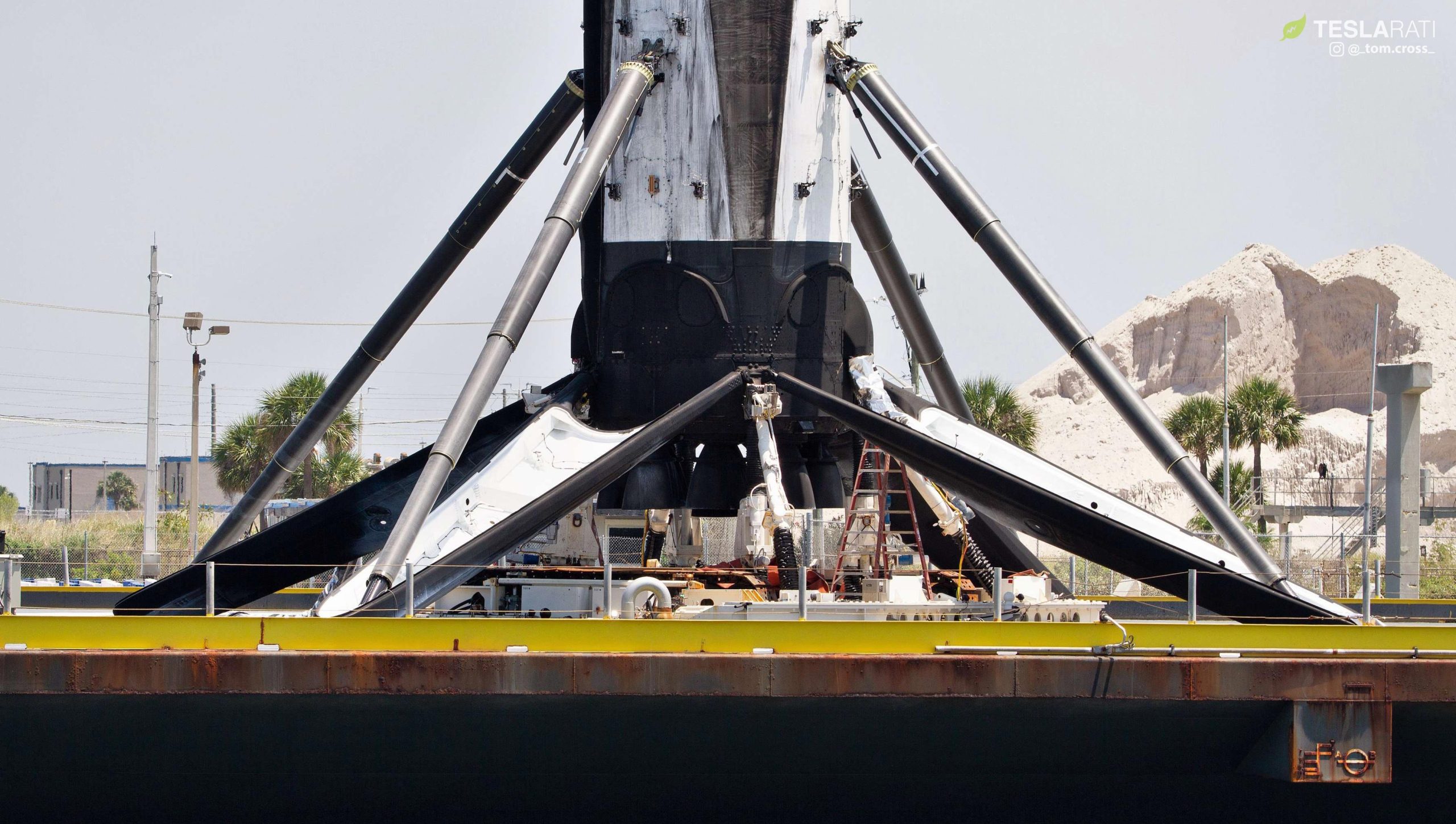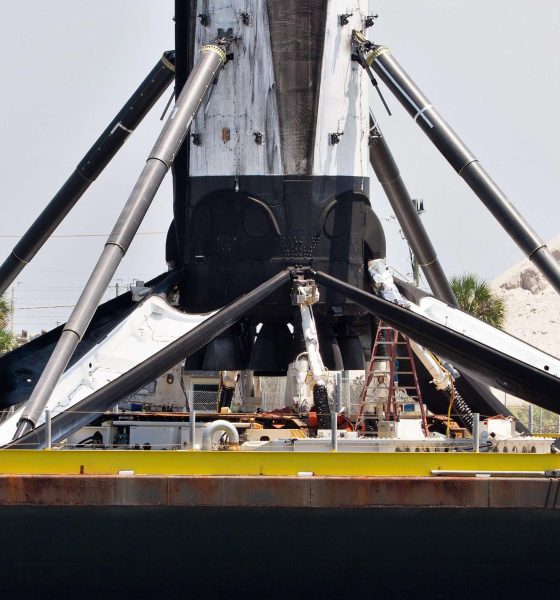

News
Kennedy Space Center wants a SpaceX Falcon 9 core for its Rocket Garden
SpaceX continues to make history with nearly every Falcon rocket launch, so it’s only fitting that one of the most well-known places for preserving rocket history, Kennedy Space Center (KSC) in Florida, would be interested in adding one of the company’s recovered cores to a display. SpaceX’s ‘flight proven’ collection is, after all, piling up. Even more relevant, however, is that most of those historic launches took place at KSC’s Launch Complex 39A.
After the Mars-bound enterprise successfully launched its third Falcon Heavy rocket this week, including the self-landed recovery of both side boosters, KSC directly voiced its interest in a SpaceX addition to their famous Rocket Garden display.
“Hint: We think a #Falcon9 and/or #FalconHeavy booster would look great in the Rocket Garden. ? We have the space available and the capability to make it happen,” Therrin Protze, COO of KSC’s Visitor Complex, tweeted to Elon Musk.
The request was quickly met with a positive reception by SpaceX’s CEO, confirming to fans and KSC visitors alike that both parties involved in making a display happen were on board with the idea. “Sure, that would be an honor,” Musk later replied after describing his admiration for the display. “I love the KSC rocket garden. Spent many days there looking at rocket design details.”
Sure, that would be an honor
— Elon Musk (@elonmusk) June 26, 2019

Kennedy Space Center’s Rocket Garden is currently home to a collection of rockets representing NASA’s Mercury, Gemini, and Apollo programs, including a Mercury-Redstone 3 rocket like the ones that put the first three American into space – Alan Shepard, Virgil “Gus” Grissom, and Ham the chimpanzee. Interestingly enough, while the Rocket Garden represents human achievements in space travel, the addition of a recovered Falcon core would represent the only resident to have actually left Earth, a distinction that wasn’t necessary only a few years ago. In effect, SpaceX’s success in recovering as much of each launch vehicle as possible would cast a new light on Rocket Garden tours with a Falcon in its midst, increasing expectations that one-and-done space travel is now largely a thing of the past.
If all goes well and a deal comes out of the SpaceX and KSC affirmations, the rocket will eventually join a few others in line to dot the country with space-faring Falcon cores. Among those planned is a display at Houston Space Center in Texas via a deal inked in May this year. The rocket is initially planned to be on its side and raised off the ground to allow visitors to walk underneath. One of the special aspects of Falcon’s presence in Houston, itself full of incredible spaceflight history, is why the Center chose to include a SpaceX vehicle in its display collection.
“[We want to]… interpret the history of the space program, but also interpret for the public what is currently going on and where we are going moving on into the future,” William Harris, president and CEO of Space Center Houston, said in an interview with collectSPACE. “With the relationship that NASA has with the commercial sector in support of the International Space Station and other missions, I felt we really needed to begin interpreting that as well.”
SpaceX also has plans for its very own rocket garden alongside an expanded presence at its launch facility in Florida. The company aims to build a dedicated facility for storing, refurbishing and decommissioning Falcon 9 and Falcon Heavy boosters and payload fairings “immediately” after construction approvals are granted, according to an environmental assessment published in April 2018. Included in the plan are 50 acres of land, a 130,000 square foot facility (with and additional 100,000 square-foot facility option, if needed), and a place to display decommissioned Falcon 9 and Falcon Heavy boosters, recovered fairings, and its Dragon spacecraft, assuming they won’t be donated to museums instead.
Until the construction for all planned sites are completed, SpaceX’s Hawthorne, California headquarters has the only Falcon on display for visitors to admire. The first booster the company recovered in December 2015 stands 156 feet tall on the corner of Crenshaw Boulevard and Jack Northrop Avenue, and it has since been the site for an untold number of visitors taking selfies, sharing their excitement for SpaceX’s achievements all over social media. Until more flight-proven cores are distributed, fans will have to just make due watching Falcon cores come home after ocean drone ship landings.

News
Tesla starts showing how FSD will change lives in Europe
Local officials tested the system on narrow country roads and were impressed by FSD’s smooth, human-like driving, with some calling the service a game-changer for everyday life in areas that are far from urban centers.

Tesla has launched Europe’s first public shuttle service using Full Self-Driving (Supervised) in the rural Eifelkreis Bitburg-Prüm region of Germany, demonstrating how the technology can restore independence and mobility for people who struggle with limited transport options.
Local officials tested the system on narrow country roads and were impressed by FSD’s smooth, human-like driving, with some calling the service a game-changer for everyday life in areas that are far from urban centers.
Officials see real impact on rural residents
Arzfeld Mayor Johannes Kuhl and District Administrator Andreas Kruppert personally tested the Tesla shuttle service. This allowed them to see just how well FSD navigated winding lanes and rural roads confidently. Kruppert said, “Autonomous driving sounds like science fiction to many, but we simply see here that it works totally well in rural regions too.” Kuhl, for his part, also noted that FSD “feels like a very experienced driver.”
The pilot complements the area’s “Citizen Bus” program, which provides on-demand rides for elderly residents who can no longer drive themselves. Tesla Europe shared a video of a demonstration of the service, highlighting how FSD gives people their freedom back, even in places where public transport is not as prevalent.
What the Ministry for Economic Affairs and Transport says
Rhineland-Palatinate’s Minister Daniela Schmitt supported the project, praising the collaboration that made this “first of its kind in Europe” possible. As per the ministry, the rural rollout for the service shows FSD’s potential beyond major cities, and it delivers tangible benefits like grocery runs, doctor visits, and social connections for isolated residents.
“Reliable and flexible mobility is especially vital in rural areas. With the launch of a shuttle service using self-driving vehicles (FSD supervised) by Tesla in the Eifelkreis Bitburg-Prüm, an innovative pilot project is now getting underway that complements local community bus services. It is the first project of its kind in Europe.
“The result is a real gain for rural mobility: greater accessibility, more flexibility and tangible benefits for everyday life. A strong signal for innovation, cooperation and future-oriented mobility beyond urban centers,” the ministry wrote in a LinkedIn post.
News
Tesla China quietly posts Robotaxi-related job listing
Tesla China is currently seeking a Low Voltage Electrical Engineer to work on circuit board design for the company’s autonomous vehicles.

Tesla has posted a new job listing in Shanghai explicitly tied to its Robotaxi program, fueling speculation that the company is preparing to launch its dedicated autonomous ride-hailing service in China.
As noted in the listing, Tesla China is currently seeking a Low Voltage Electrical Engineer to work on circuit board design for the company’s autonomous vehicles.
Robotaxi-specific role
The listing, which was shared on social media platform X by industry watcher @tslaming, suggested that Tesla China is looking to fill the role urgently. The job listing itself specifically mentions that the person hired for the role will be working on the Low Voltage Hardware team, which would design the circuit boards that would serve as the nervous system of the Robotaxi.
Key tasks for the role, as indicated in the job listing, include collaboration with PCB layout, firmware, mechanical, program management, and validation teams, among other responsibilities. The role is based in Shanghai.
China Robotaxi launch
China represents a massive potential market for robotaxis, with its dense urban centers and supportive policies in select cities. Tesla has limited permission to roll out FSD in the country, though despite this, its vehicles have been hailed as among the best in the market when it comes to autonomous features. So far, at least, it appears that China supports Tesla’s FSD and Robotaxi rollout.
This was hinted at in November, when Tesla brought the Cybercab to the 8th China International Import Expo (CIIE) in Shanghai, marking the first time that the autonomous two-seater was brought to the Asia-Pacific region. The vehicle, despite not having a release date in China, received a significant amount of interest among the event’s attendees.
Elon Musk
Elon Musk and Tesla AI Director share insights after empty driver seat Robotaxi rides
The executives’ unoccupied tests hint at the rapid progress of Tesla’s unsupervised Robotaxi efforts.

Tesla CEO Elon Musk and AI Director Ashok Elluswamy celebrated Christmas Eve by sharing personal experiences with Robotaxi vehicles that had no safety monitor or occupant in the driver’s seat. Musk described the system’s “perfect driving” around Austin, while Elluswamy posted video from the back seat, calling it “an amazing experience.”
The executives’ unoccupied tests hint at the rapid progress of Tesla’s unsupervised Robotaxi efforts.
Elon and Ashok’s firsthand Robotaxi insights
Prior to Musk and the Tesla AI Director’s posts, sightings of unmanned Teslas navigating public roads were widely shared on social media. One such vehicle was spotted in Austin, Texas, which Elon Musk acknowleged by stating that “Testing is underway with no occupants in the car.”
Based on his Christmas Eve post, Musk seemed to have tested an unmanned Tesla himself. “A Tesla with no safety monitor in the car and me sitting in the passenger seat took me all around Austin on Sunday with perfect driving,” Musk wrote in his post.
Elluswamy responded with a 2-minute video showing himself in the rear of an unmanned Tesla. The video featured the vehicle’s empty front seats, as well as its smooth handling through real-world traffic. He captioned his video with the words, “It’s an amazing experience!”
Towards Unsupervised operations
During an xAI Hackathon earlier this month, Elon Musk mentioned that Tesla owed be removing Safety Monitors from its Robotaxis in Austin in just three weeks. “Unsupervised is pretty much solved at this point. So there will be Tesla Robotaxis operating in Austin with no one in them. Not even anyone in the passenger seat in about three weeks,” he said. Musk echoed similar estimates at the 2025 Annual Shareholder Meeting and the Q3 2025 earnings call.
Considering the insights that were posted Musk and Elluswamy, it does appear that Tesla is working hard towards operating its Robotaxis with no safety monitors. This is quite impressive considering that the service was launched just earlier this year.








